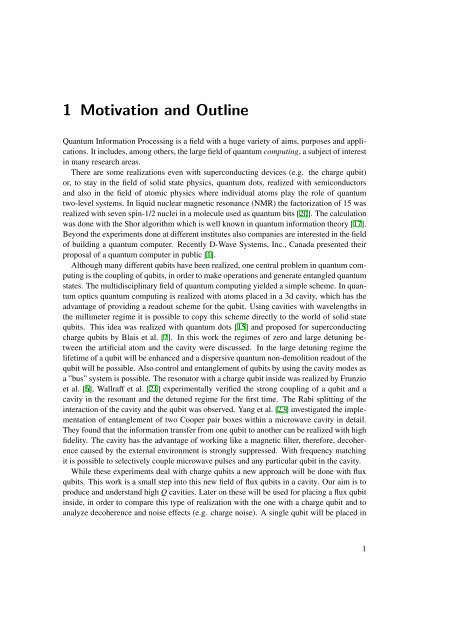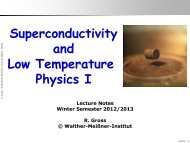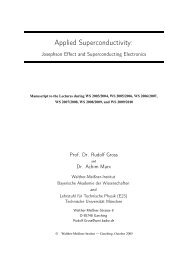Design, Fabrication and Characterization of a Microwave Resonator ...
Design, Fabrication and Characterization of a Microwave Resonator ...
Design, Fabrication and Characterization of a Microwave Resonator ...
You also want an ePaper? Increase the reach of your titles
YUMPU automatically turns print PDFs into web optimized ePapers that Google loves.
1 Motivation <strong>and</strong> OutlineQuantum Information Processing is a field with a huge variety <strong>of</strong> aims, purposes <strong>and</strong> applications.It includes, among others, the large field <strong>of</strong> quantum computing, a subject <strong>of</strong> interestin many research areas.There are some realizations even with superconducting devices (e.g. the charge qubit)or, to stay in the field <strong>of</strong> solid state physics, quantum dots, realized with semiconductors<strong>and</strong> also in the field <strong>of</strong> atomic physics where individual atoms play the role <strong>of</strong> quantumtwo-level systems. In liquid nuclear magnetic resonance (NMR) the factorization <strong>of</strong> 15 wasrealized with seven spin-1/2 nuclei in a molecule used as quantum bits [20]. The calculationwas done with the Shor algorithm which is well known in quantum information theory [17].Beyond the experiments done at different institutes also companies are interested in the field<strong>of</strong> building a quantum computer. Recently D-Wave Systems, Inc., Canada presented theirproposal <strong>of</strong> a quantum computer in public [1].Although many different qubits have been realized, one central problem in quantum computingis the coupling <strong>of</strong> qubits, in order to make operations <strong>and</strong> generate entangled quantumstates. The multidisciplinary field <strong>of</strong> quantum computing yielded a simple scheme. In quantumoptics quantum computing is realized with atoms placed in a 3d cavity, which has theadvantage <strong>of</strong> providing a readout scheme for the qubit. Using cavities with wavelengths inthe millimeter regime it is possible to copy this scheme directly to the world <strong>of</strong> solid statequbits. This idea was realized with quantum dots [15] <strong>and</strong> proposed for superconductingcharge qubits by Blais et al. [2]. In this work the regimes <strong>of</strong> zero <strong>and</strong> large detuning betweenthe artificial atom <strong>and</strong> the cavity were discussed. In the large detuning regime thelifetime <strong>of</strong> a qubit will be enhanced <strong>and</strong> a dispersive quantum non-demolition readout <strong>of</strong> thequbit will be possible. Also control <strong>and</strong> entanglement <strong>of</strong> qubits by using the cavity modes asa ”bus” system is possible. The resonator with a charge qubit inside was realized by Frunzioet al. [6], Wallraff et al. [21] experimentally verified the strong coupling <strong>of</strong> a qubit <strong>and</strong> acavity in the resonant <strong>and</strong> the detuned regime for the first time. The Rabi splitting <strong>of</strong> theinteraction <strong>of</strong> the cavity <strong>and</strong> the qubit was observed. Yang et al. [23] investigated the implementation<strong>of</strong> entanglement <strong>of</strong> two Cooper pair boxes within a microwave cavity in detail.They found that the information transfer from one qubit to another can be realized with highfidelity. The cavity has the advantage <strong>of</strong> working like a magnetic filter, therefore, decoherencecaused by the external environment is strongly suppressed. With frequency matchingit is possible to selectively couple microwave pulses <strong>and</strong> any particular qubit in the cavity.While these experiments deal with charge qubits a new approach will be done with fluxqubits. This work is a small step into this new field <strong>of</strong> flux qubits in a cavity. Our aim is toproduce <strong>and</strong> underst<strong>and</strong> high Q cavities. Later on these will be used for placing a flux qubitinside, in order to compare this type <strong>of</strong> realization with the one with a charge qubit <strong>and</strong> toanalyze decoherence <strong>and</strong> noise effects (e.g. charge noise). A single qubit will be placed in1
















